Bundle Product
A bundle is a build your own, customizable product. Each item in a bundle can be based on one of the following product types:
- Simple Product
-
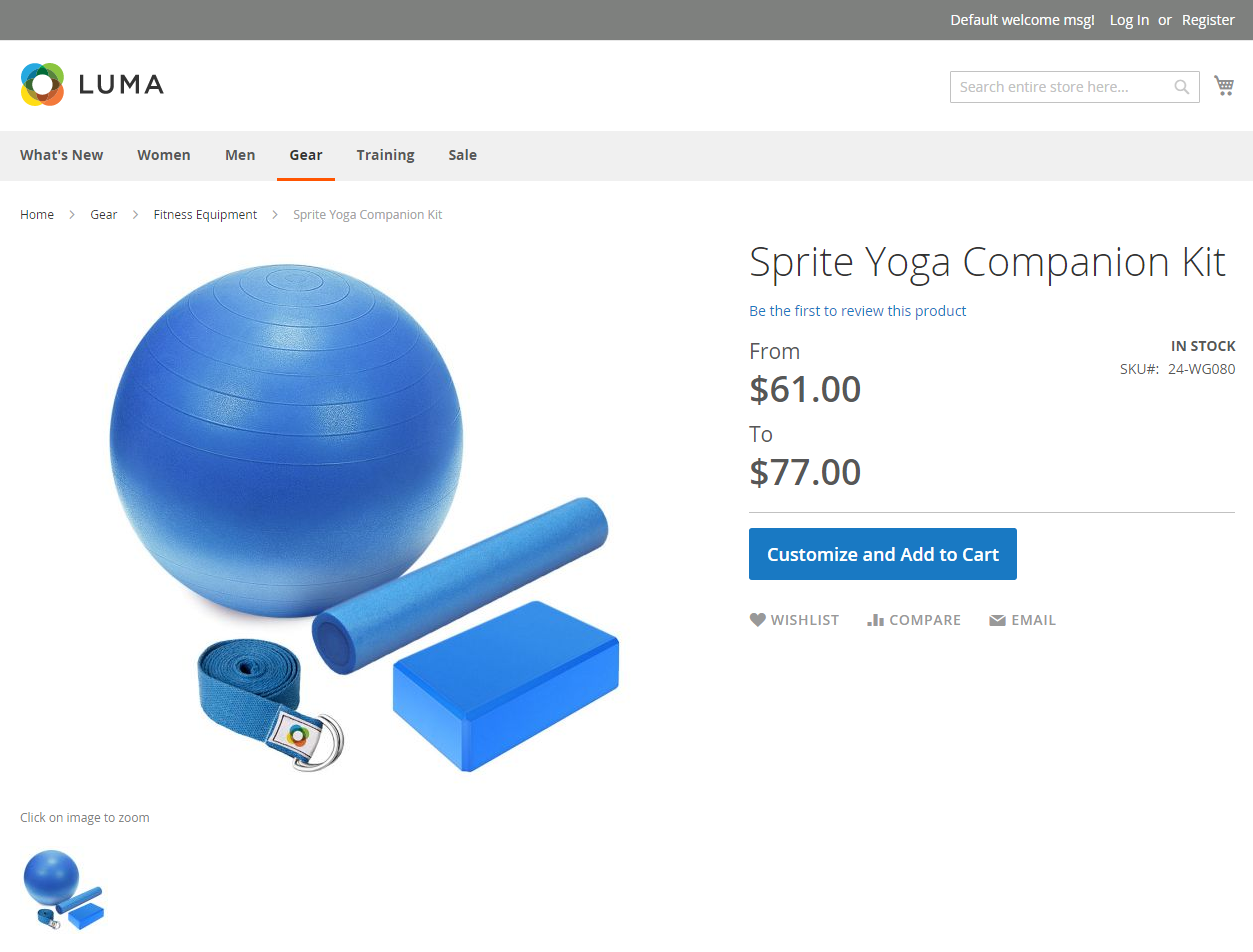 Bundle Product
Bundle Product
The options appear when the customer clicks either Customize or Add to Cart. Because the products that are included in the bundle vary, the SKU, Price, and Weight can be set to either a dynamic or fixed value.
Minimum Advertised Price (MAP) is not available for Bundle products that use dynamic pricing.
If Instant Purchase is available, the Instant Purchase button appears below the Add to Cart button for each item in the bundle.
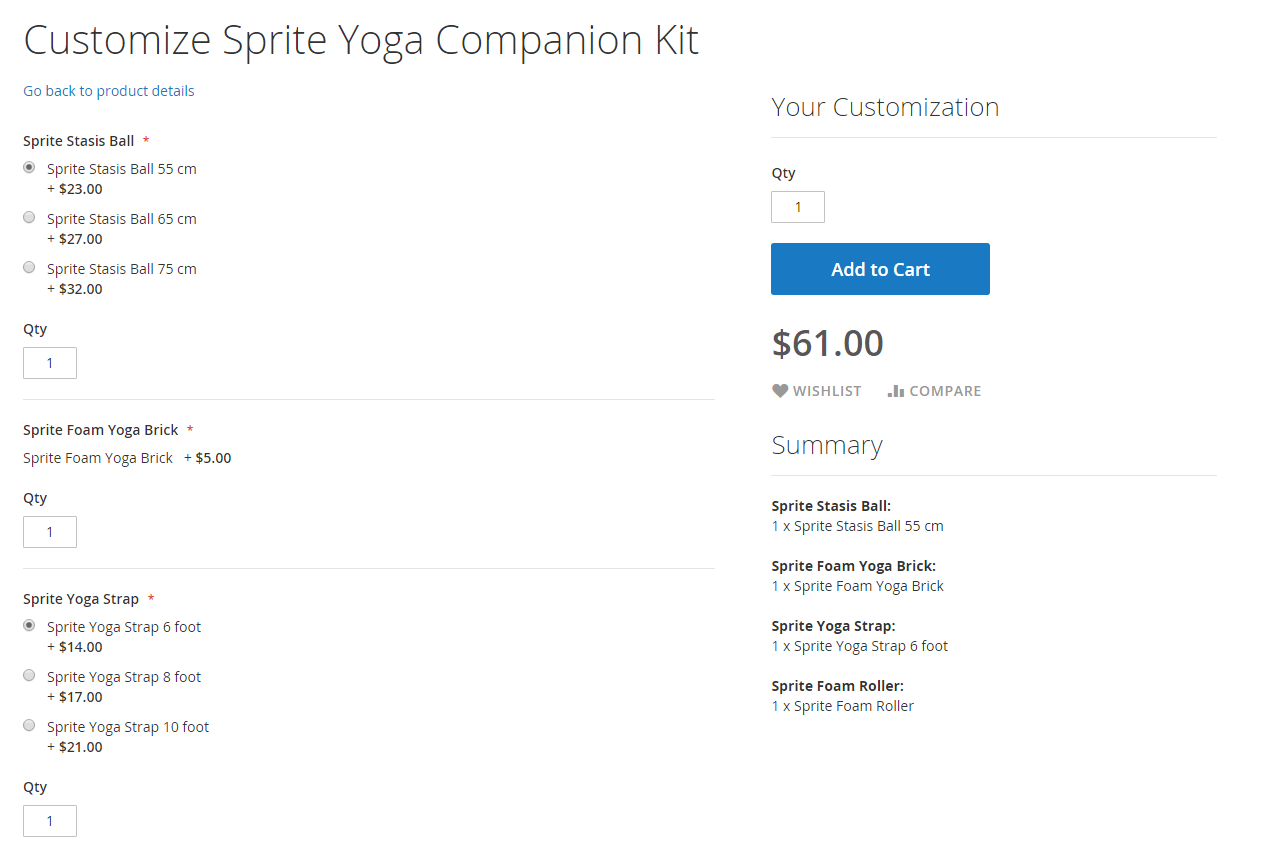 Customize Bundle
Customize Bundle
The following instructions take you through the process of creating a bundle product using a product template, required fields, and basic settings. Each required field is marked with a red asterisk (*). When you finish the basics, you can complete the advanced settings and other settings as needed.
Step 1: Choose the product type
-
On the Admin sidebar, go to Catalog > Products.
-
In the upper-right corner on the Add Product (
 ) menu, choose Bundle Product.
) menu, choose Bundle Product.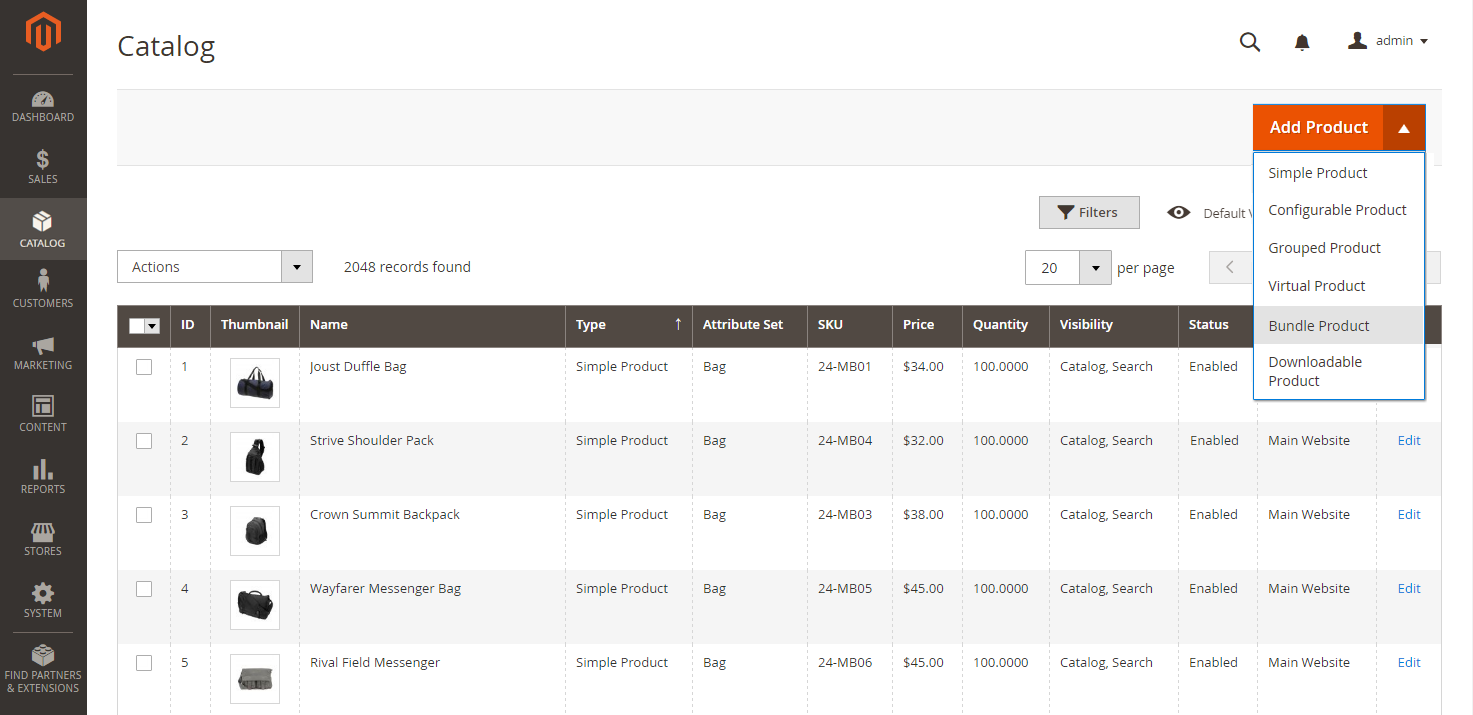 Add Bundle Product
Add Bundle Product
Step 2: Choose the attribute set
To choose the attribute set that is used as a template for the product, do one of the following:
- For Search, enter the name of the attribute set,
- In the list, choose the attribute set that you want to use.
The form is updated to reflect the change.
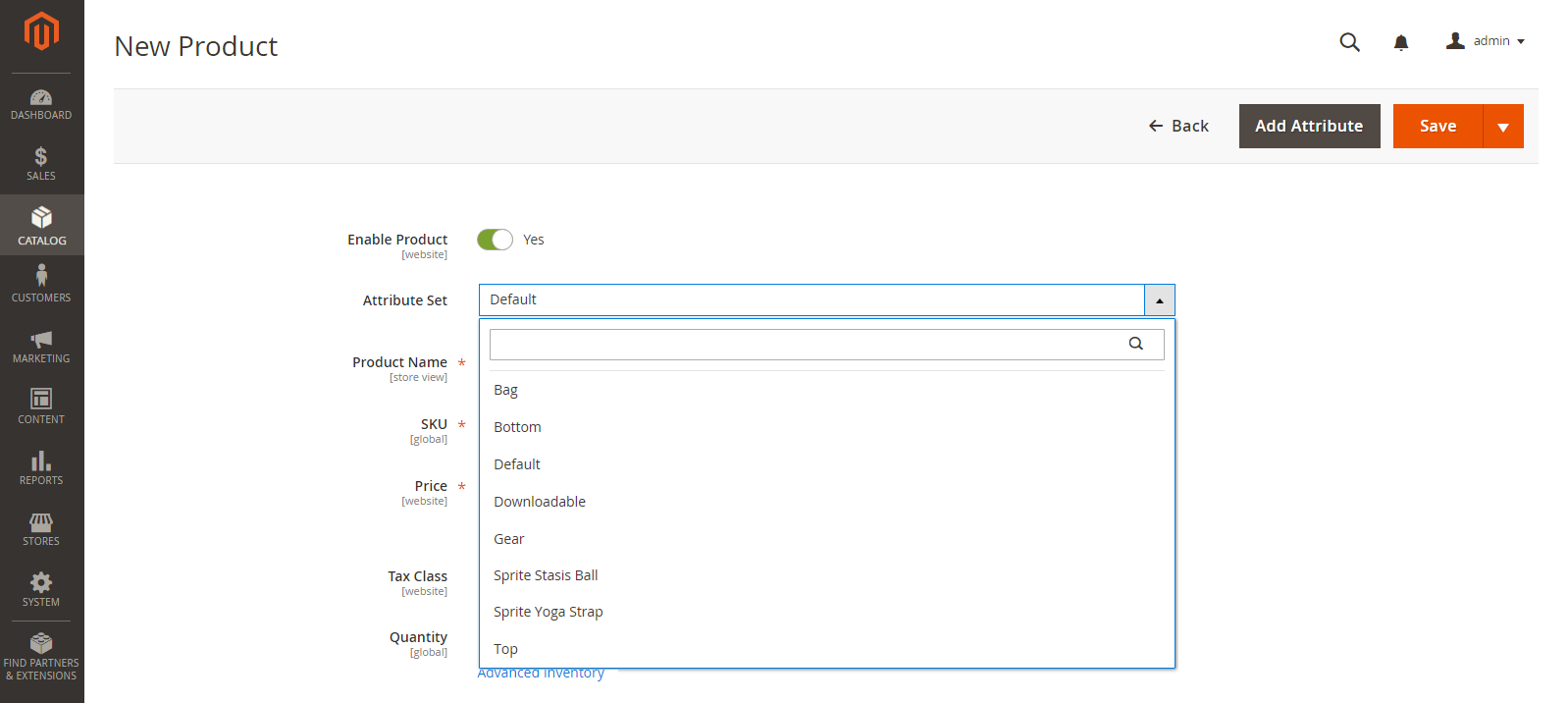 Choose Template
Choose Template
Step 3: Complete the required settings
-
Enter the product Product Name.
-
Either accept the default SKU that is based on the product name or enter a different value.
To determine the type of SKU that is assigned to each bundle item, do the following:
-
A Dynamic SKU can be assigned automatically to each bundle item by adding a suffix to the default SKU. By default, this is set to
Yes. -
If you prefer to assign a unique SKU for each bundle item, set Dynamic SKU to
No.
 Dynamic SKU and Price
Dynamic SKU and Price -
-
To determine the price of the bundle, do one of the following:
-
To have the price reflect the options chosen by the customer, set Dynamic Price to
Yesand leave Price blank. -
To charge a fixed price for the bundle, set Dynamic Price to
Noand enter the Price that you want to charge for the bundle.
-
-
Because the product is not yet ready to publish, set Enable Product to
No. -
Click Save and continue.
When the product is saved, the Store View chooser appears in the upper-left corner.
-
Choose the Store View where the product is to be available.
 Choose Store View
Choose Store View
Step 4: Complete the basic settings
-
If the bundle has Fixed Pricing, set Tax Class to one of the following:
NoneTaxable Goods
If the bundle has Dynamic Pricing, the tax is determined for each bundle item.
-
Take note of the following:
-
The Quantity is not available because the value is determined for each bundle item.
-
By default, the Stock Status is set to
In Stock.
-
-
To determine the weight of the bundle, do one of the following:
-
To have the weight reflect the options chosen by the customer, set Dynamic Weight set
Yesand leave Weight blank. -
To assign a fixed weight to the bundle, set Dynamic Weight to
Noand enter the Weight of the bundle.
 Dynamic Weight
Dynamic Weight -
-
To feature the product in the list of new products, select the Set Product as New checkbox.
-
Accept the default Visibility setting of
Catalog, Search. -
To assign Categories to the product, click the Select… box and do either of the following:
Choose an existing category:
-
Start typing in the box to find a match.
-
Select the checkbox of each category that is to be assigned.
Create a new category:
-
Click New Category.
-
Enter the Category Name and choose the Parent Category to determine its position in the menu structure.
-
Click Create Category.
-
-
Choose the Country of Manufacture.
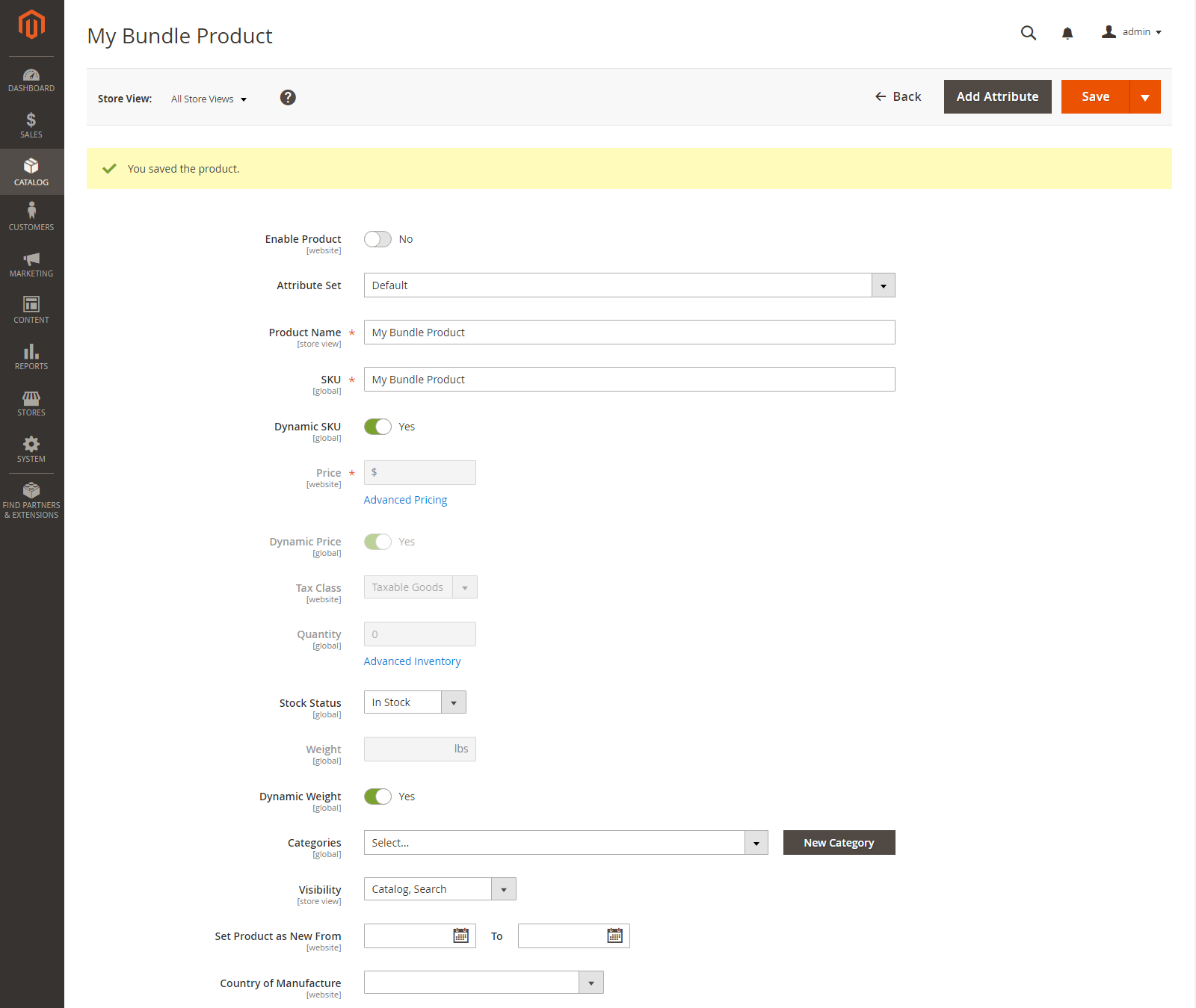 Bundle Details
Bundle DetailsThere might be additional attributes that describe the product. The selection varies attribute set, and you can complete them later.
Step 5: Add the bundle items
-
Scroll down to the Bundle Items section and set Ship Bundle Items to one of the following:
SeparatelyTogether
 Bundle Items
Bundle Items -
Click Add Option and do the following:
 Add Bundle Options
Add Bundle Options-
Enter an Option Title to be used as the field label.
-
Set Input Type to one of the following:
Drop-downRadio buttonsCheckboxMultiple Select
-
To make the field a required entry, select the Required checkbox.
-
Click Add Products to Option and select the checkbox of each product that you want to include in this option.
If there are many products, use the list filters and pagination controls to find the products you need.
-
Click Add Selected Products.
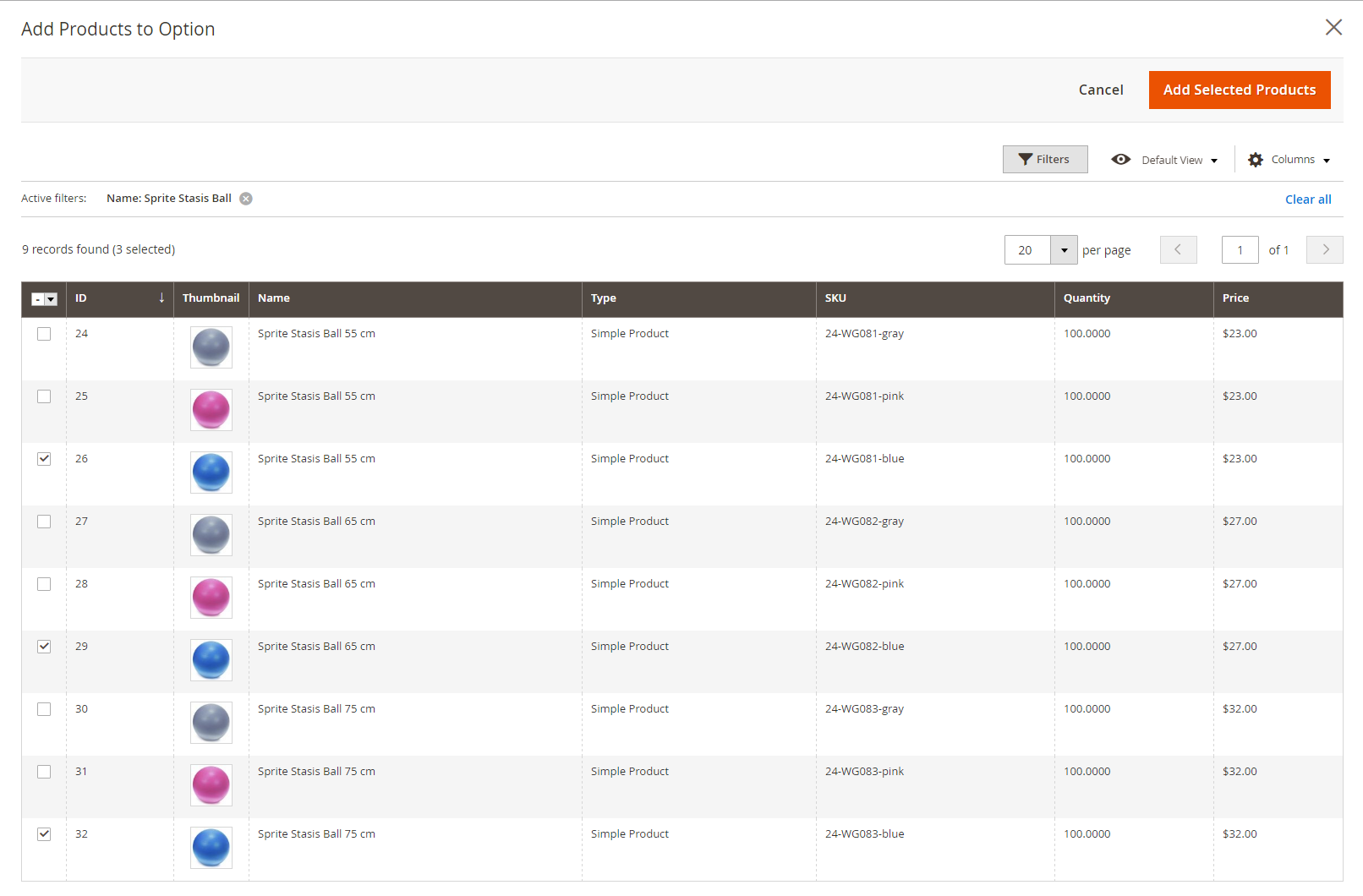 Add Selected Products
Add Selected Products -
After the items appear in the Options section, choose an item to be the Default selection.
-
In the Default Quantity column, enter the quantity of each item that is to be added to the bundle when a customer chooses the item.
-
To allow customers to change the quantity of a bundle item, select User Defined.
The quantity can be a preset or user-defined value. However, do not assign the User Defined property to checkbox or multiple-select input types.
By default, the Default Quantity that is included in a bundle item cannot be changed by the customer. However, the customer can enter the quantity of the item that is to be included in the bundle.
For example, if the Default Quantity of the Sprite Status Ball is set to
2and the customer orders4of that bundle option, the total number of total balls purchased is8. Item Detail
Item Detail
-
-
Repeat these steps for each item you want to add to the bundle.
-
To change the order of items in a bundle section, click the Move (
 ) icon at the beginning of the row and drag the item into position.
) icon at the beginning of the row and drag the item into position.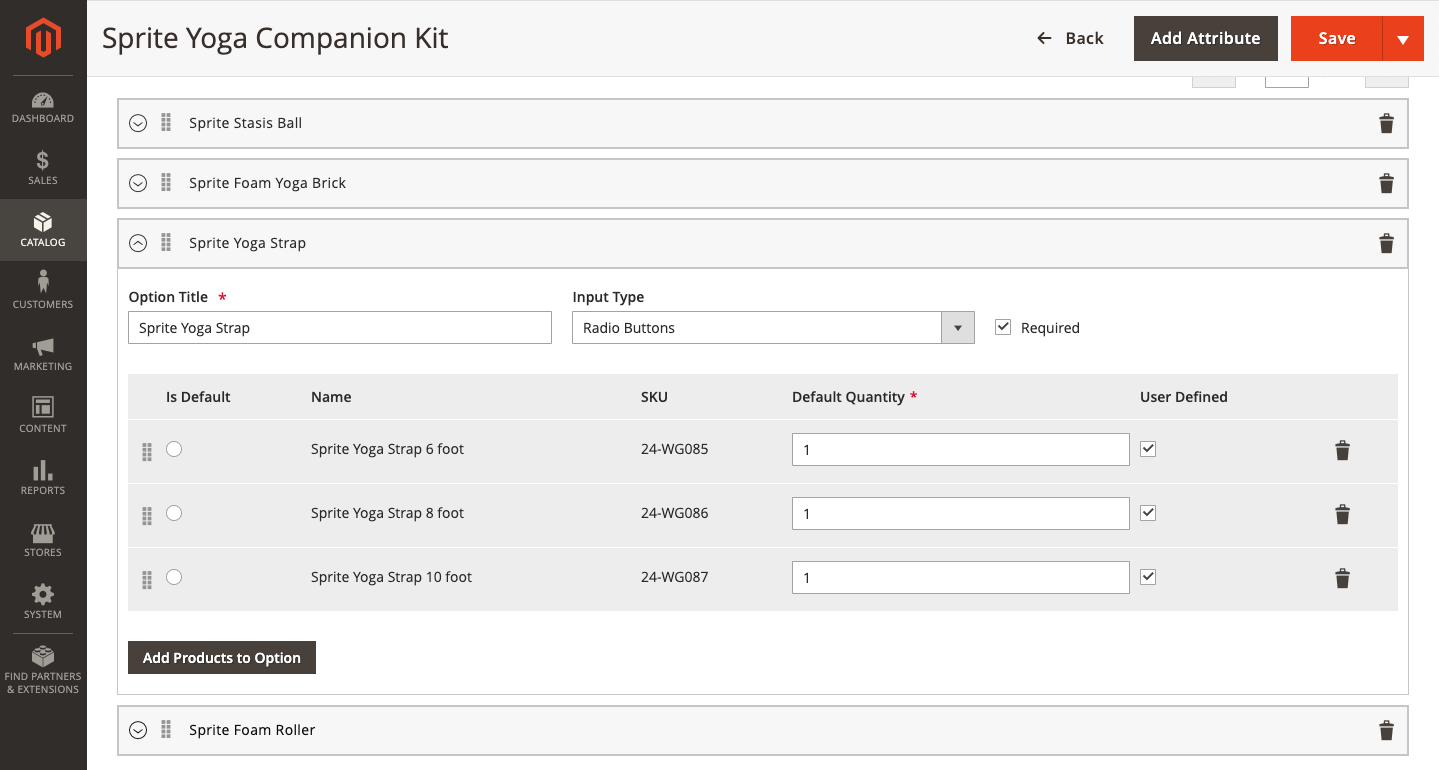 Change the Order of Bundle Items
Change the Order of Bundle ItemsThe order of items can also be changed in the data of an exported bundle product and then reimported into the catalog. For more information, see Importing Bundle Products.
-
To change the order of sections in a bundle product, click the Move (
 ) icon in the header of the section and drag the section to the new position.
) icon in the header of the section and drag the section to the new position.To have a better view of the workspace, collapse each section first and then drag them into position.
 Change the Order of Bundle Sections
Change the Order of Bundle Sections -
To remove any item from the bundle, click the Delete (
 ) icon.
) icon. -
When complete, click Save.
Step 6: Complete the product information
Scroll down and complete the information in the following sections as needed:
- Content
- Images and Videos
- Search Engine Optimization
- Related Products, Up-Sells, and Cross-Sells
- Customizable Options
- Products in Websites
- Design
- Gift Options
Step 7: Publish the product
-
If you are ready to publish the product in the catalog, set Enable Product to
Yes( ).
). -
Do one of the following:
-
Method 1: Save and preview
- In the upper-right corner, click Save.
- To view the product in your store, choose Customer View on the Admin (
 ) menu.
) menu.
The store opens in a new browser tab.
 Customer View
Customer View -
Method 2: Save and close
On the Save (
 ) menu, choose Save & Close.
) menu, choose Save & Close. Save & Close
Save & Close
-
Input controls
| Control | Description | Example |
|---|---|---|
| Drop-down | Displays a drop-down list of options with the product name and price. Only one item can be selected. |  |
| Radio Buttons | Displays a radio button for each option, followed by the product name and price. Only one item can be selected. |  |
| Checkbox | Displays a checkbox for each option, followed by the product name and price. Multiple items can be selected. |  |
| Multiple Select | Displays a list of options with the product name and price. To select multiple items, hold down the Ctrl key (PC) or the Command key (Mac) and click each item. |  |
Field descriptions
| Field | Description |
|---|---|
| SKU | Determines if each item is assigned a variable or dynamic SKU or if a fixed SKU is used for the bundle. Options: Fixed / Dynamic. |
| Weight | Specifies whether the weight is calculated based on the items selected or is a fixed weight for the entire bundle. Options: Fixed / Dynamic. |
| Price View | Determines if the product price is shown as a range, from the least expensive to the most expensive (Price Range) or with the least expensive shown (As Low As). Options: Price Range / As Low As. |
| Ship Bundle Items | Specifies if individual items can be shipped separately. |
Things to remember
 |
Customers can build their own bundle product. |
 |
Bundle items can be simple or virtual products without custom options. |
 |
The Price View can be set to either Price Range or As Low As. |
 |
SKU and Weight can be either Fixed or Dynamic. |
 |
The quantity can be a preset or user-defined value. However, do not assign the User Defined property to checkbox or multiple-select input types. |
 |
Bundle items can be shipped together or separately. |